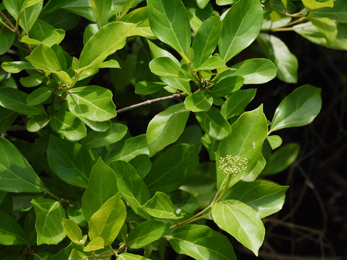 Agnimantha is very essential medicinal plant mentioned in texts since Vedic period. It is described as one of ten herbs of dashmoola. Agni means fire and mantha means to shake and its wood is rubbed together to produce fire in ancient times. This herb is best vatahara and shothhara according to Acharya Charak. Agnimantha is a flowering plant in laminaceae/vibernaeceae family. It resembles like large shrub or small trees growing up to 9 meters in height. It is found with yellow bark and brown colored woody aromatic root. It is small herb commonly distributed in India and Sri Lanka. It grows along with other plants in a group. It has simple, ovate, opposite, membranous and irregularly toothed leaves. Flowers of this herb are small white colored with unpleasant smell. Fruits are saucer shaped calyx that surround the base, black when ripened.
Agnimantha is very essential medicinal plant mentioned in texts since Vedic period. It is described as one of ten herbs of dashmoola. Agni means fire and mantha means to shake and its wood is rubbed together to produce fire in ancient times. This herb is best vatahara and shothhara according to Acharya Charak. Agnimantha is a flowering plant in laminaceae/vibernaeceae family. It resembles like large shrub or small trees growing up to 9 meters in height. It is found with yellow bark and brown colored woody aromatic root. It is small herb commonly distributed in India and Sri Lanka. It grows along with other plants in a group. It has simple, ovate, opposite, membranous and irregularly toothed leaves. Flowers of this herb are small white colored with unpleasant smell. Fruits are saucer shaped calyx that surround the base, black when ripened.
Largely known variety is called Agnimantha and less known variety is called tarkari. 2-3 herbs are used in the name of Agnimantha.
- Clerodendrum phlomidis
- Premna mucronata/Premna corymbosa
Chemical composition of Clerodendrum phlomidis contains pectolinarigenin, hispidium, cleodendrin, raffinosa etc.
Premna mucronata is B-sitosterol, lutoelin, premnine, botulin, ganikarine, premenol and ganiarine.
SPECIAL NOTE ABOUT AGNIMANTHA
Agnimantha, Jaya, Vataghni and Sriparna are the various names of this herb because of its various features.
अग्निं मध्नाति दीपनत्वात् अग्निमन्थ:
When sticks of Agnimantha are rubbed together they produce fire that is why it is called Agnimantha.
It helps to overcome various diseases and called jaya.
It helps to pacify vata dosha thus called vataghan
Due to very beautiful appearance of leaves it is called sriparna.
HABITAT OF AGNIMANTHA
Agnimantha is widely distributed throughout India. It is found mostly in dried parts. It is easily available in upper gangetic plains, Uttarpradesh, Bihar and Orrisa etc. it is also easily available in coastal areas of southern India and dry regions of western coast. It is also found in banks of ganges and Bengal. Flowering season of this plant is from April to June.